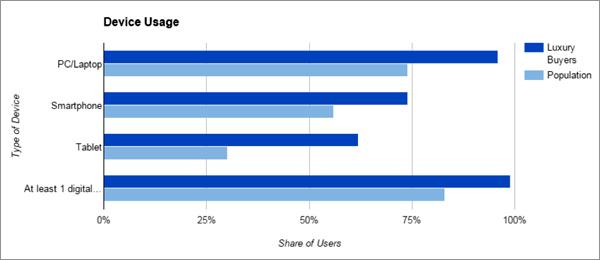Commentary
Best Practices For Digital Luxury Brand Campaigns
- by Andy Kahl , June 25, 2015
The most successful luxury brands combine understated dignity with the ability to command attention when the time is right. This is reflected in nearly every aspect of advertising directed toward Affluents — subtle color palettes, limited copy, even sparse appearances by the product itself. Online, luxury brand advertisers see the best performance from ad formats that capture the same aesthetic.
Luxurious Video:Proven Strategy, New Channel
For an actor or model, landing the role of spokesperson for a brand can be a prestigious and lucrative accomplishment. Luxury brands have strategically aligned themselves with famous personalities with whom their affluent audience can identify. Video advertising has been a natural extension of this strategy, allowing these brand representatives to speak directly with the audience and often interact with the product itself. This promise of direct interaction allows luxury advertisers to find success with video advertising, outpacing the benchmarks set by brand advertisers on the whole.
advertisement
advertisement
Rich Media Ads with Video | ||
Interaction Rate | Click Rate | |
Benchmark | 2.81% | 0.17% |
Luxury | 3.60% | 0.39% |
Source: Sizmek platform data, 2014
HTML5: Technological Affluence
In the world of digital advertising, the most trendsetting format for advertisements is HTML5. Supported across all devices and capable of compelling interactivity, HTML5 allows designers to immerse their audience in the brand while seamlessly fitting in with the design of the page and dynamically reacting to the size of the screen.
Affluent audiences respond to this experience. Consumers interact with expandable banners from luxury brands nearly twice as often as the overall average.
HTML5 Expandable Banners | ||
Interaction Rate | Click Rate | |
Benchmark | 4.58% | 0.37% |
Luxury | 8.06% | 0.81% |
Source: Sizmek platform data, 2014
Finding Affluents in the Wild
Reaching affluent users requires a multi-channel approach. Not only do 99% of luxury buyers use at least one digital device, but they’re more likely to use mobile devices.
Source: Google Think Insights, 9/2013
Mobile advertising is critical, further reinforcing the strong strategic connection between affluent shoppers and HTML5, mobile-friendly ads. As you might suspect, however, luxury brand shoppers trail behind the general population in online purchases. Sixty-nine percent of luxury buyers also said that they preferred to see and touch a product before buying. So using geolocation technology to identify affluents (particularly those on mobile devices) and direct them to a nearby showroom—aka reverse showrooming—is a key strategy to influencing a purchase. Advertisers can further optimize their digital strategies by linking offline purchase information with online accounts to help target audiences with a demonstrated affinity for their brand and further increase their lifetime value.
Opulence Through Data
The kinds of data exclusive to online advertising can be used to better target the niche affluent audience with content and messaging that is memorable and retains the brands luxury image. Advanced content models can be created to target narrow segments based on a brand’s audience intelligence, and to protect the brand from content that would be detrimental by association. And sophisticated reach attribution between search, display, and social media channels can drive future media investment and help to evaluate success.
On the whole, luxury brands have a lot to gain by seeking out their affluent audience online. While some aspects of digital inventory may present a challenge to these brands, opportunities clearly exist for luxury brands to effectively engage with their selected user base. A combination of proven advertising techniques and new data-driven tactics can create the same kind of prosperity in a digital campaign that defines the brands they represent.




Contrary to conventional wisdom (and the author's assertion), "limited copy, even sparse appearances by the product itself" is probably not the best way to attract and sell affluent consumers, most of which are not familiar with true luxury products and brands. They need a bit of brand and product education. Our research also shows that celebrity endorsements are not effective with the truly affluent (wealthiest 10% of U.S. households).
We agree with Ron. Our research indicates that 35% of the Top 10% (and 15% of the 1%) are Apprentices, meaning they have had wealth for less than five years. They are adapting to a new lifestyle with the recession a not too distanct memory. They need to be educated about why should they spend their new, hard-earned money on luxury products and experiences.